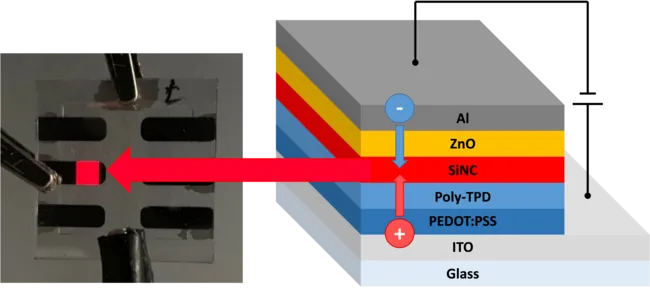QLEDs
We are part of the international ATUMS research group for hybrid functional materials
(https://www.department.ch.tum.de/makro/irtg-2022-atums/overview/)
where researchers and engineers from chemistry, physics and electrical engineering take part. Our partner in Canada is the University of Alberta in Edmonton with complementary research topics. In our project, we are focusing on optoelectronic devices and sensors, mainly with nano-sized Silicon such as Silicon nanocrystals (SiNCs) as active material.
We fabricate SiNC-LEDs or Si quantum dot LEDs (Si-QLEDs) which are an interesting alternative to organic light emitters. The advantage of QLEDs is that they are mostly inorganic and show a narrower emission spectra combined with a potential flexibility of the OLEDs. The drawback of the commonly used II-VI and IV-VI nanocrystals is that they are based on Cd or Pb, for example, CdSe and PbS and therefore toxic. Since the European Union wants to reduce the amount of toxic materials in electronics, alternatives such as SiNCs are needed.
We get tailor made SiNCs in close cooperation from the chemistry department at TUM to fabricate and characterize the SiNC-LEDs. Each SiNC-LED consists of many different layers where most of them are deposited from solution with a thickness between 10 nm and 100 nm, keeping the opportunity to implement the process in roll-to-roll fabrication and flexible LEDs in the future. We analyze the layers and LEDs with different material and surface characterization tools to gain a better understanding on the light generation mechanisms and efficiency. Light-emitting polymers or nanoparticles are usually non-monochromatic emitters, as their valence and conduction bands are not sharply defined. The change in emission by interference, material defects or surface groups on SiNCs can change the color and intensity. Therefore, the samples are measured in home-build setups as well as in industrial standardized characterization tools. That involves quantum efficiency, spectra, viewing-angle and lifetime measurements.
Funding and Duration
GRK 2022: Alberta/Technical University of Munich International Graduate School for Environmentally Responsible Functional Hybrid Materials (ATUMS)
(International Research Training Groups),
Duration: 2015-2024
Cooperation Partners
Technische Universität München TUM
University of Alberta UofA
Contact
TUM: Markus Becherer, Bernhard Rieger
UofA: Frank Hegmann, Jonathan Veinot, Al Meldrum
Doctorial Candidates: Josef Mock, Matthias Golibrzuch
Homepage
https://www.department.ch.tum.de/makro/irtg-2022-atums/overview/
